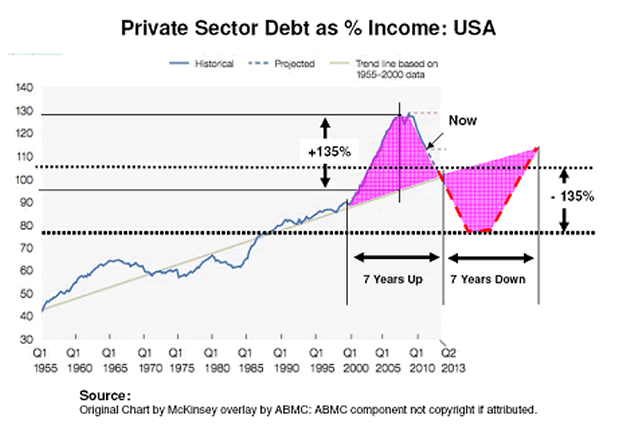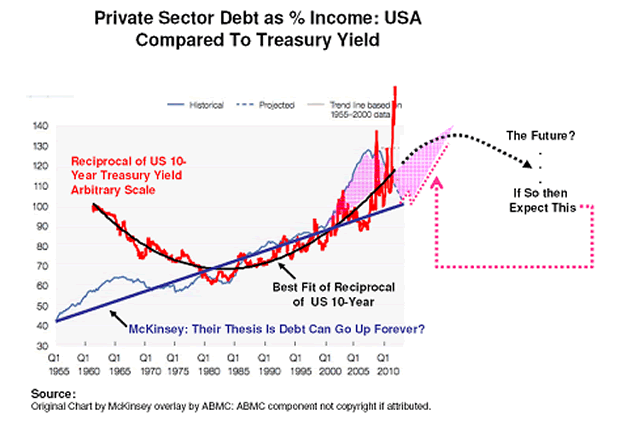How Far Will Debt Deleveraging Go? How Much LSD Can an Elephant Take?
Interest-Rates / US Debt Feb 02, 2012 - 02:01 AM GMTBy: Andrew_Butter
 There is a growing suspicion that the amount debt piled on by both government and the private sector in developed nations over the past few years, is causing distressing symptoms of overdose.
There is a growing suspicion that the amount debt piled on by both government and the private sector in developed nations over the past few years, is causing distressing symptoms of overdose.
On the subject of overdose, any druggie will tell you, dosage is important. Get that wrong and you can suffer unintended consequences. The other thing, once you popped the pills and the substance is absorbed into your blood, well, you just got to hang on and bear the consequences, until the stuff works its way through your system, if you don’t die first.
A sad fact of life is that even the experts can get it wrong. For example, in 1965 a peer reviewed paper appeared in the erudite and highly respectable journal “Science”, which described the reaction of a male elephant to LSD as part of a research program to investigate a condition called “Musth”; which is when domesticated elephants become violent and uncontrollable.
So the diligent researchers calculated the dose required for a “trip”, and they injected 297 mg into the beast. Who immediately started trumpeting and running around, then he stopped and swayed, then he collapsed, went into convulsions, defecated, and five minutes later, he died. The authors concluded that elephants must be unusually sensitive to LSD.
Sounds a bit like what happened in America and Europe recently. Except there the drug was debt and the experts were economists, and like the story of the elephant, it never occurred to the experts that they might have made a mistake.
In the case of the elephant, what went wrong was, as is explained by Knut Schmidt-Nielsen in his classic book, “How Animals Work”, is that the dosage was calculated from what’s required to send a cat into a rage, multiplied by the ratio of the weight of a cat compared to the weight of an elephant. The correct way to calculate dosage turns out to be from considering both the ratio of metabolic rate, and relative brain weight, which works out somewhere between 0.4 mg and 3 mg (if ever you want to try that out at home).
Try asking any of the architects of the current Charlie Foxtrot, how do you calculate how much debt you need to overdose, and why? Isn’t it interesting, that if you ask ten different world-famous experts, you will get ten different answers, and that’s after the drug has been injected and is coursing around the system. Personally, before I self-medicate, I always read the small print.
Now some are talking “cold turkey” and some are talking “hair of the dog”, and all an innocent bystander can do, is reflect on the last agonizing moments of that unfortunate elephant, surrounded by experts wearing white coats and writing their detailed observations down on their clip-boards..
There is a good article by McKinsey about debt which John Maudlin posted:
http://www.marketoracle.co.uk/Article32776.html
But as usual, like most economic analysis, it’s disappointing; there is a lot of interesting information (thank you very much), but they don’t tell you what the answer is, as in how much debt-induced-LSD will it take to kill the elephant?
Here is a chart they put up.

I superimposed that with the Theory of the Pebble in The Pond worked out for their logic; which is that the trend-line of Private Sector Debt as % Income is a straight line going up.
They say we are half-way back to “normal”.
I beg to disagree with their implied and un-stated logic, if that’s what you can call it; the Pebble in the Pond Theory says that if the McKinsey trend is your friend, then to “cure” the system from the effects of the overdose, private sector debt is going to need to go down to 80% of income not 100%. That’s illustrated by the purple triangles, the basic idea there is “what goes up comes down”, that was Newton’s big idea, if Physics Envy is your thing.
Any less, and well, ask yourself, what happens when you keep feeding a druggie a reduced dosage, just to stop him stealing money to feed his habit? And that’s of course assuming that the ratio will “naturally” keep on going up forever.
Now where did I hear that one before? Mm…I’m thinking here, it’s coming…it’s on the tip of my tongue…oh yes, I REMEMBER!!
Remember that one about “house prices will keep going up forever”,
Which was, at the time, so much the conventional wisdom of the experts that the rating agencies didn’t have an option on their valuation models to put in a negative number for the change in the price of housing, not even minus 1%, when they were using their golden stamp to brand AAA on the rumps of synthetic collateralized debt obligations, and Greek government bonds? Err…Minus 35% so far sweetheart and counting!
What I don’t understand is how all the PhD Nobel Prizewinning economists and experts of that era can still show their faces in public, as in “sweetheart, perhaps you should look for other employment, how about cleaning lavatories, that shouldn’t be too hard”.
Assumption is the Mother of All Frappuccinos.
Go on; ask a pontificating puffed-up expert, soon to be an expert on cleaning lavatories…how much debt is the right dose, and why?
Except the experts studiously duck that question, McKinsey are experts, and they go on and on about this and that, except they never get to asking that question, let alone attempting to answer it.
How about this one?

Me, I’m not an expert, I just do valuations and 15-year forward cash-flow projections; a lot of the time that’s to paint a rosy picture for some 24-Year old with a PhD in economics and an attitude, to persuade him (never her) to tick a box that will allow my customer to borrow more money than is good for him.
And the question constantly asked when you go through that process, is how much debt is “good?”
One of the interesting things that I have observed over many years of patiently educating 24-Year old PhD economists about the birds and the bees; is that no one is remotely interested in the other-than-market value of the collateral. As in how much might you reasonably expect to be able to sell that for in the event that, horror, at some indeterminate time in the future, the lovely person with the impeccable credentials, doesn’t pay you your money back (with interest).
All anyone is ever interested in is the debt service coverage ratio (DSCR), and the big variable there is…you guessed it, see high-finance it isn’t actually that hard (no pun intended)!
Yes…it’s the interest rate you have to pay!!! Darn, you’d think this would be hard, given all the Nobel Prizewinning debt druggies wandering around in a haze, but really it’s not.
What we are observing as the slow motion farce in Europe unfolds to its crescendo is that simple fact, if you have to pay a higher rate of interest on your debt, you can’t have so much; that’s of course if you can’t rely on Goldman Sachs to slip some Rohypnol into the water of the 24-year old economists that you need to tick the boxes.
Me? NO I never did that! PROMISE cross my heart, I never did…but I admit, I did think about it.
Looking at the chart, I have no explanation for how come up to 1975 or so, talking recent history, the American private sector was borrowing a lot less than was apparently “good-for-it”, although I suspect that the invention of new-fangled financial and economic techniques, which started about that time, enabled average Americans to start sampling the delicious drug of debt.
Intriguing also, that’s about the time the cost of importing oil started to become a significant part of the current account deficit of many developed countries.
So What’s the Answer?
The reason US Treasury yields are so low now is a combination of the actions of the Fed, plus the disintegration of Europe (so anyone who doesn’t trust a bank buys US Treasuries), plus the fact that there is a 95% correlation between lagging US nominal GDP growth and US Treasury yields, which is why, in February 2010 it was obvious to anyone who was not a trained economist or a hyper-ventilating hyper-inflationist, that the yields on US long-debt were set to go down, not up.
http://www.marketoracle.co.uk/Article27011.html
But so long as they keep Rambo in his cage, US nominal GDP is going to go up; America is not perfect, but it’s an approximation of free-market economics, and if you want to see how that theory works look at Dubai:
http://www.marketoracle.co.uk/Article32728.html
So medium term, yields will go up, to 3% at least, as soon as Europe either does the Elephant overdosing on LSD trick, or recovers (with a Big hangover), one or the other it doesn’t matter which, I just wish they would get on with it.
One thing that’s important to remember is a lot of what is called “sovereign-debt” in Europe, is quasi private sector, the money was borrowed to keep certain privileged members of the community, such as unions and public sector “servants” (scroungers would be a better word), in the lifestyle they were accustomed to. The dilemma of democracy is that when the scroungers start to represent a significant part of the electorate, and the politicians ask their focus groups to tell them what the “people” want, the unanimous message that comes back, is “More LSD”.
As soon as that’s clear, and when the detritus left behind after all those five course lunches for the economic mandarins in Brussels, gets cleared away, the ten year US Treasury could go up to 4.5% for a while.
Although only temporarily (that’s the Peddle in the Pond Theory again); there will have to be a lot more growth (nominal, whether that’s inflation or “real” is irrelevant), before the fundamental (other than market value), shifts significantly away from 3%.
That’s going to start happening in about five years time, that’s if the elephants don’t run out of oil first, which is the big unknown.
http://www.marketoracle.co.uk/Article30202.html
By Andrew Butter
Twenty years doing market analysis and valuations for investors in the Middle East, USA, and Europe. Ex-Toxic-Asset assembly-line worker; lives in Dubai.
© 2012 Copyright Andrew Butter- All Rights Reserved
Disclaimer: The above is a matter of opinion provided for general information purposes only and is not intended as investment advice. Information and analysis above are derived from sources and utilising methods believed to be reliable, but we cannot accept responsibility for any losses you may incur as a result of this analysis. Individuals should consult with their personal financial advisors.
Andrew Butter Archive |
© 2005-2022 http://www.MarketOracle.co.uk - The Market Oracle is a FREE Daily Financial Markets Analysis & Forecasting online publication.



